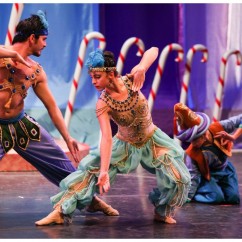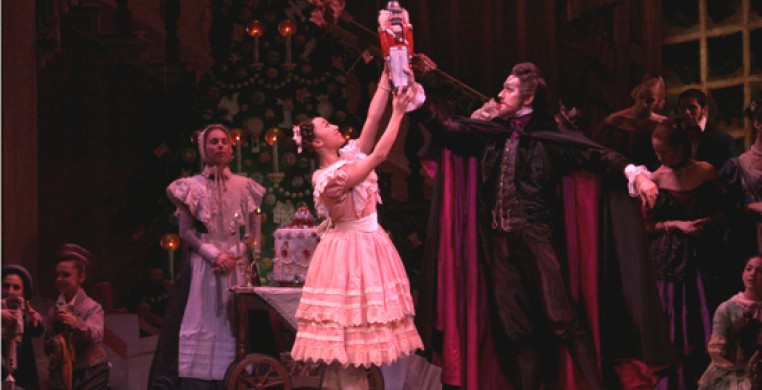The Nutcracker ballet comes in all shapes and sizes. This past weekend saw opening nights of two Chicago Nutcrackers that have each played an important role in Chicago dance history, creating holiday traditions and setting the standard for its production. The Joffrey Ballet celebrates the final season and 28th consecutive year of founding director, Robert Joffrey’s 1987 Nutcracker, while the Ruth Page Civic Ballet observes the 50th anniversary of Miss Page’s 1965 production, which ran annually at McCormick place until 1997.
The Nutcracker Ballet harkens back to the original E.T.A. Hoffman tale, “The Nutcracker and The Mouse King,” first conceived as a ballet and performed in St. Petersburg, Russia, in 1892. A thin story-line provides enough of a skeleton for Tchaikovsky’s delicious score and a dream ballet with a full buffet of tasty variations as well as one of classical ballet’s most honored pas de deux.
Both the Joffrey and the Civic productions re-set the traditional tale in 19th-century America, and each has given hundreds of Chicago area children the chance of a lifetime to perform in a grand theater with world-class professional dancers. Many of these same children have grown up to grace Joffrey and Civic Ballet Nutcracker stages as professional dancers today.
This year, the Joffrey’s stunning production seems even more effervescent than ever. Robert Joffrey’s Act I Victorian American drawing room has all the excitement and freshness of a world premiere. And it’s not just Oliver Smith’s gorgeous scenery, the superb detail in costuming, or the near perfection of soloists and corps de ballet. The acting in both juvenile and adult roles makes this production sparkle with dramatic flair, holding interest despite the simplicity of the story. Where most productions offer generic parents and kiddies, each of these party guests has his or her own identity. Cara Marie Gary’s pre-adolescent romantic illusions as Clara, Hansol Jeong’s sibling rivalry as Fritz, Dylan Gutierrez and Mahallia Ward’s attentive collusion in parenting as the Stahlbaums are all vividly drawn and individually specific. Michael Smith brings particular fun to Drosselmeyer’s over-the-top eccentricity with a decidedly mysterious subtext.
Layered staging that blends a flurry of complex theatrical scene-building with choreographed sequences, creates believability and visual interest in the organized chaos of an opulent 19th-century Christmas party. American folk dance forms infuse the formal dance sequences with period authenticity without skimping on ballet substance.
Mechanical dolls Caitlin Meighan as Columbine and Yoshi Arai as Harlequin hatch out of giant cupcakes to entertain onstage guests with a parody of comedia del’arte love, and soldier dolls Anastacia Holden and Derrick Agnoletti demonstrate superb technical command in their exaggerated military rigidity. And we must not forget the children, beautifully trained, adorable to behold, but most of all, the true messengers of meaning, through whose eyes the audience is enabled to relive the magic of Christmas.
Joffrey’s use of Tchaikovsky’s music to create drama on stage is particularly inventive in sustaining a sense of suspense that builds throughout Act I. Live music, performed by the Chicago Philharmonic under the inspired direction of Scott Speck, adds immeasurably to the wonder and magic of the whole.
The Joffrey Ballet has a tradition of democratic Nutcracker casting that rotates its dancers in multiple roles throughout the run of 28 performances. The Nutcracker season gives more company dancers more opportunities to develop solo roles than at any other time during the year. This year’s opening night featured some of the younger or newer company members in lead roles, while Joffrey ballerina nonpareil Victoria Jaiani played convincingly in the background as a superannuated maiden aunt in Act I, in good company with fellow Joffrey stars Christine Rocas and Rory Hohenstein, among the chorus of party “Guests.”
I can’t remember ever being so mesmerized by the exquisite beauty of Scene iii “Land of Snow,” which showcased the glistening elegance of Ward and Gutierrez as the Snow Queen and Snow King amidst a blizzard of precision Snowflakes. Company newcomer Hansol Jeong took a spectacular turn as the Snow Prince, with high-flying grands jetés and the most air-born pas de chats I’ve ever seen.
Ethereal Sugar Plum Fairy Amanda Assucena, recently promoted from the Joffrey Academy, and handsome boy-next-door Alberto Velasquez as the Nutcracker Prince hosted Act II’s “Kingdom of Sweets,” a smorgasbord of international dishes with character-dance-based variations. Company newcomer Nicole Ciapponi danced “Chocolate from Spain” with saucy abandon. Dara Holmes’ pliable spine and Temur Suluashvili’s sensual partnering made “Coffee From Arabia” a crowd pleaser highlighted by her 180-degree penché arabesque holding only the ends of her scarf for support
Velaquez’s adoring attention as Assucena’s zealous cavalier created a dramatic connection that added warmth and humanity to their impeccable display of one of ballet’s real tests of mettle in the Grand Pas de Deux, the highlight of Act II.
Robert Joffrey’s Nutcracker has been a cherished Chicago tradition for 20 years. During that time, we have witnessed the integration of this New York transplant company into the fiber of our city’s cultural center, so that now, we can truly call the Joffrey our own.
The Joffrey Ballet has pulled out all the stops in a fitting farewell season to its first Nutcracker. True to its founding director’s spirit of artistic pioneering, the company has commissioned Christopher Wheeldon to choreograph a brand new Nutcracker for next year. Until then we can enjoy Robert Joffrey’s parting gift to American dance at The Auditorium Theatre through December 27th. (Click on “Upcoming Events” for details and tickets.)
The Ruth Page Civic Ballet’s production of The Nutcracker continues a tradition begun by Ruth Page, grande dame of Chicago dance, with the first ever fully-professional, home-grown Chicago Nutcracker in 1965, sponsored by Chicago Tribune Charities and staged annually in the vast Arie Crown Theatre of McCormick Place for 32 years. The lavishly costumed, magnificently-staged production was Page’s “affectionate and good old-fashioned Christmas gift to the children of Chicago and their parents and friends,” giving generations of audiences an unforgettable theatre experience and for many, their first exposure to ballet.
It also gave countless worthy Chicago professionals both needed employment and an opportunity to dance grand roles on a grand stage. One of those dancers is Dolores Lipinski Long, whose memorable Sugar Plum Fairy and American Beauty Rose lit up the Arie Crown, along with the best of international ballet stars Miss Page imported annually to Chicago. Now, as co-director of The Ruth Page Civic Ballet and co-director of Miss Page’s “Nutcracker” with Victor Alexander, her demanding standards and attention to every dancing detail pay tribute to Miss Page’s legacy and to the memory of her husband, Larry Long, whose faithful execution as director of Miss Page’s work kept her vision fresh and exciting. Two other key Ruth Page Nutcracker alums, Birute Barodicaite, associate director, and Laura Wade, children’s director, are also key collaborators.
While this production may be a mere remnant of Page’s magnificent original, with a minimal set that fit easily into the Northeastern Illinois University Auditorium last weekend and travels north to Ravinia’s Bennet Gordon Hall this coming Sunday, it is faithful to many of Page’s original innovations, including setting the story in the middle of 19th-century America.
Relying on its pre-professional studio company and well-trained students for the corps de ballet and children’s roles, this production is not without its magic, and some rewarding surprises in Act II.
Foremost and quite astounding are Katherine Ochoa Lipiz as the Sugar Plum Fairy and Narciso Alejandro Medina Arias as the Cavalier, guest artists from Cuba’s Escuela Nacional de Ballet. The two carried off a seamless partnership, almost as if they had been born dancing together.
Miss Lipiz exuded warmth and radiance in the Grand Pas De Deux, her unmitigated joy matched by breathtaking technical brilliance. Arias, ever the attentive partner, handled the difficult lifts, supported balances, and pirouettes with poise and confidence. He took the stage for his solo with almost distracted nonchalance, then pulled a phenomenal variation out of his back pocket with nary a flutter, the amazing elevation and clarity of his beats, double tours, double saut de basques, and dare-devil leaps drawing audible gasps from the audience. Lipiz, wowed with spot on fouetté turns and perfect balances en pointe. But most impressive was their ability to go beyond their brilliant technique and simply dance the dickens out of that pas de deux with all their heart and soul. It was a joy to behold such promise in two burgeoning young talents, both of whom I’m sure we’ll hear from in the future.
Act I’s party scene, however, is another story, departing significantly from Miss Page’s original, save for the mechanical dolls, ably danced by Catherine Conley, John Atterbury, Molly Jones, and Marco Clemente, and the wonderful battle between toy soldiers and giant mice.
The Civic’s Act I explores the use of spoken text and dialogue, written by Tom Etlinger and William Raffeld. Integrating text and dialogue with choreography is ambitious and can be an artistically exciting hybrid, but the challenge is in sustaining quality and artistic integrity in the blend of acting, dancing, choreography, and theatrical blocking. “Show don’t tell” could have been a useful mantra here, where unconvincing line-delivery, cloying dialogue, and a real lack of meaningful stage movement traded the charm of Page’s version for a party with flat eggnog. The story- within-a-story reading from E.T.A. Hoffman’s original text slowed the works, and its pantomime accompaniment failed to illustrate the text.
Act II felt like a different ballet in both spirit and substance, with thoroughly enjoyable and charming renditions of all our favorite sweets and libations. Marco Clemente had some terrific barrel turns in “Hot Chocolate,” and Jessie Gutierrez and Julien Valme’s “Coffee” brought Miss Page’s penchant for humor and fun to the traditional Arabian variation. "Coffee"
Kristina Isabelle’s stilt-walking as “Mother Ginger” gave the character a zany mirth as she danced a mile above everyone else on the stage and even “flew” the Bonbon children in the air, much to everyone’s delight. Trepak was a big crowd-pleaser, with soloist Michel Rodriguez Cintra’s dazzling jumps and unbounding energy and enthusiasm. American Beauty Rose Sarah Marley impressed with strong technique and flair. The student dancers, integrated throughout Act II variations, were accomplished and well-rehearsed in age- and ability-appropriate choreography.
"Coffee"
Kristina Isabelle’s stilt-walking as “Mother Ginger” gave the character a zany mirth as she danced a mile above everyone else on the stage and even “flew” the Bonbon children in the air, much to everyone’s delight. Trepak was a big crowd-pleaser, with soloist Michel Rodriguez Cintra’s dazzling jumps and unbounding energy and enthusiasm. American Beauty Rose Sarah Marley impressed with strong technique and flair. The student dancers, integrated throughout Act II variations, were accomplished and well-rehearsed in age- and ability-appropriate choreography.
Ruth Page’s legacy to Chicago is still in evidence here. No one knew better how to stage a great Nutcracker. The Civic Ballet has plenty to offer, but they would do well to stick to the original.

